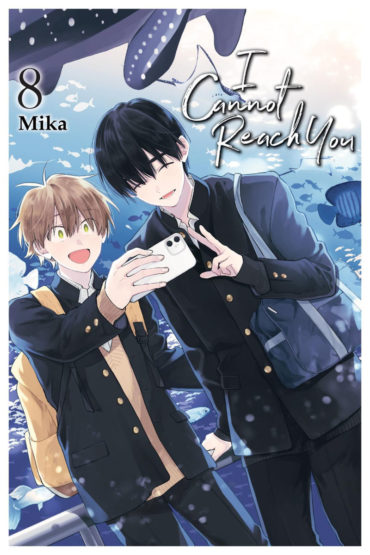I Cannot Reach You Volume 8 Review
“It’s like I can’t work out… how to act normal anymore…” Kakeru to Yamato
As their second year at high school approaches Spring Break, Kakeru and Yamato have begun dating. But these childhood friends are still not entirely used to the idea that they’re boyfriends now – and they haven’t yet told their friends. So when bespectacled Fujino (who’s always encouraging Kakeru to get a girlfriend) gives him a couple of aquarium tickets, he assumes that Kakeru will invite a girl to go with him. Instead, this becomes Kakeru and Yamato’s first date together. But it’s at the station on the way home – when Yamato forgets himself and hugs Kakeru on impulse – that their classmates Fujino, Hosaka and Amamiya just happen to be passing and see them. Kakeru, feeling bad about not sharing the news with Fujino (the other two have already guessed!) blurts out, “We went to the aquarium together. I’m going out… with Yamato!” and Fujino says nothing but just looks dazed. After this, Fujino seems to go out of his way to avoid Kakeru (even though they’ve been best buddies since the high school entrance examinations) and Kakeru, always one for straight-talking, starts to beat himself up about it. He steels himself to confront Fujino and apologise for not having been up-front with him from the start. But it’s Yamato who seeks Fujino out first to explain and say he’s sorry, telling Kakeru, “It’s our problem.”
All five classmates decide to go away together over Spring Break: a two-day, one-night camping holiday in the mountains. They call it camping, but in fact they rent a two-bedroom wooden holiday cabin. Only two bedrooms? There’s no way Kakeru and Yamato can room together on a trip with their friends (!) so after rock-paper-scissors, Kakeru gets to share with Hosoka and Fujino, and Yamato with easy-going Amamiya. The weather is good, there’s fishing in the nearby river (and, Kakeru being Kakeru, of course he falls in) and a barbecue. Kakeru also manages to get lost looking for a special scenic venue nearby – will Yamato be able to find him (because, of course, mobile phone signals are unreliable)?
Eight volumes in to I Cannot Reach You (and a well-liked TV series on Netflix) and the tortuous relationship between the childhood friends is still problematic for both protagonists. Kakeru frequently says to Yamato, “I’m your boyfriend” as if he’s still trying to convince himself, adding an undercurrent of uncertainty for the reader too. The strengths of this likeable Boys’ Love series (enhanced by Mika’s art which is as expressive as ever) are still in the conversations and interactions between the young protagonists which feel very authentic. Mika highlights all the uncertainties and insecurities of being in love for the first time, as well as the looming pressures of moving from second year to third year in high school. Mika also highlights the difference in maturity between Yamato (who struggles to rein back his desires, which seem to be becoming harder to control) and Kakeru (who still seems less physically mature, often presenting as charmingly yet frustratingly naïve).
Childhood friends to lovers is such a favourite subject in manga that it could be classed as one of the enduring romance themes of our time. I can’t help wondering how many couples today first met as children (excepting arranged marriages) in real life as in this very mobile twenty-first century of ours, the likelihood of still hanging out with childhood friends, let alone dating and marrying them, is probably quite small. However, the fantasy remains as potent as ever with readers and viewers. And with its Teen rating, it’s a great choice for secondary school libraries.
This holiday idyll for the boys may prove to be fleeting; the mangaka recently wrote on X, ‘From Volume 9 onwards, the school year will move up and we will be facing a new system. We plan to draw characters that have not been in Kimi nai [I Cannot Reach You] up until now, so I hope everyone will find a new favourite.’ Looming over Kakeru and Yamato is the possibility that they’ll be placed in different classes for their final year.
Volume 8 has been translated again for Yen Press by Jan Mitsuko Cash with lettering by Alexis Eckerman; the translation reads very smoothly as before, helped by the lettering choices. There are four attractive colour pages at the front and translation notes at the back as well as a brief afterword from the mangaka about the TV show (this volume came out in Japan at the time when the TV series had just been confirmed). We’ve caught up with Japan in that Volume 9 has not yet been released; we can but hope it will be published in 2025.
Our review copy from Yen Press was supplied by Diamond Book Distributors UK.


